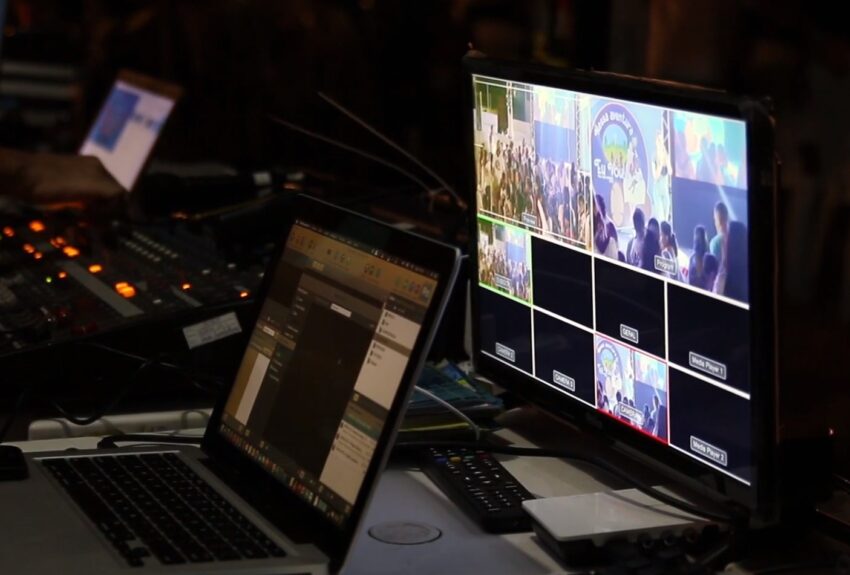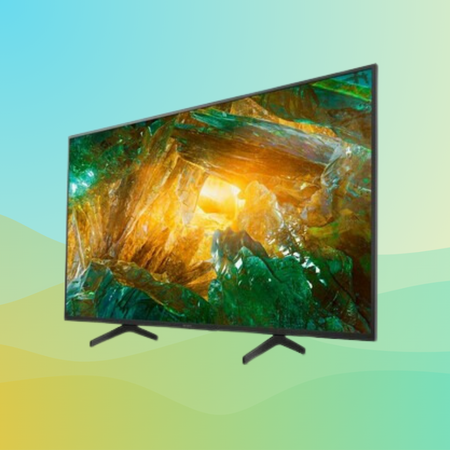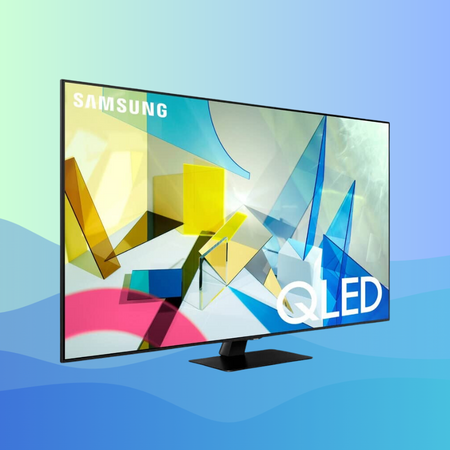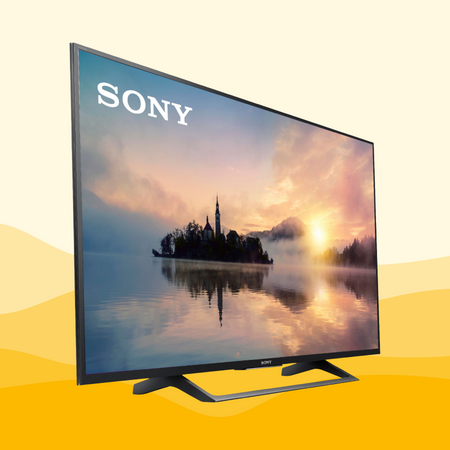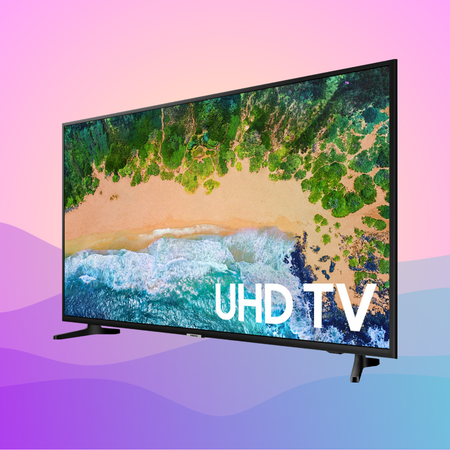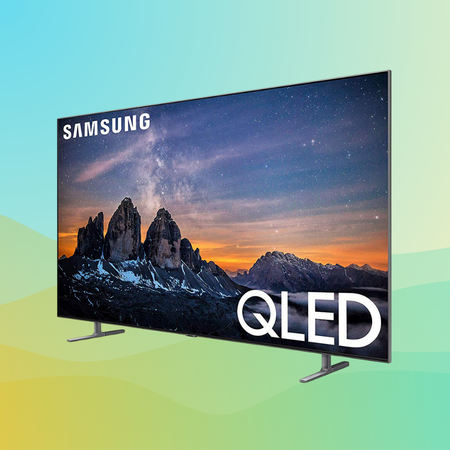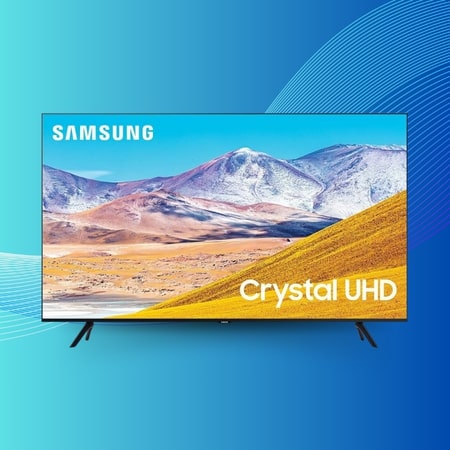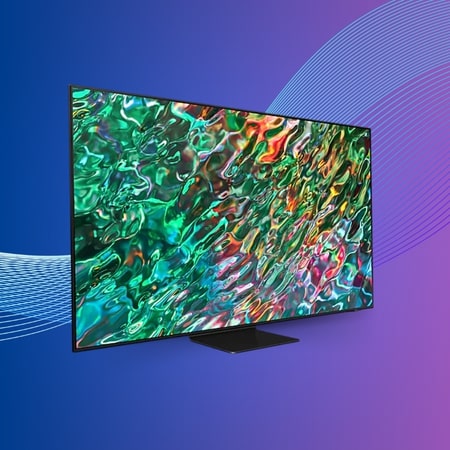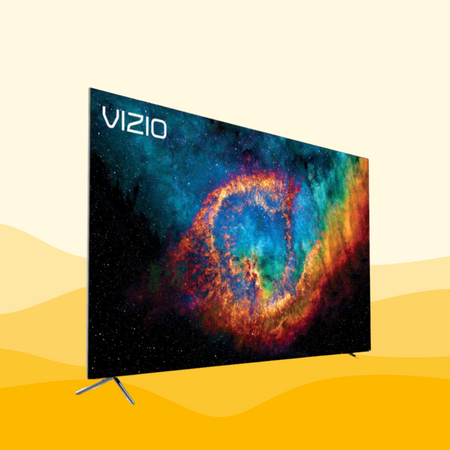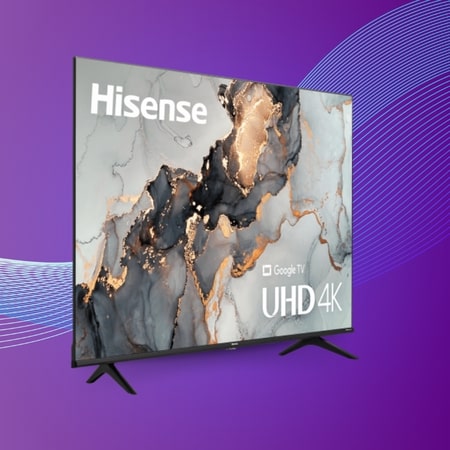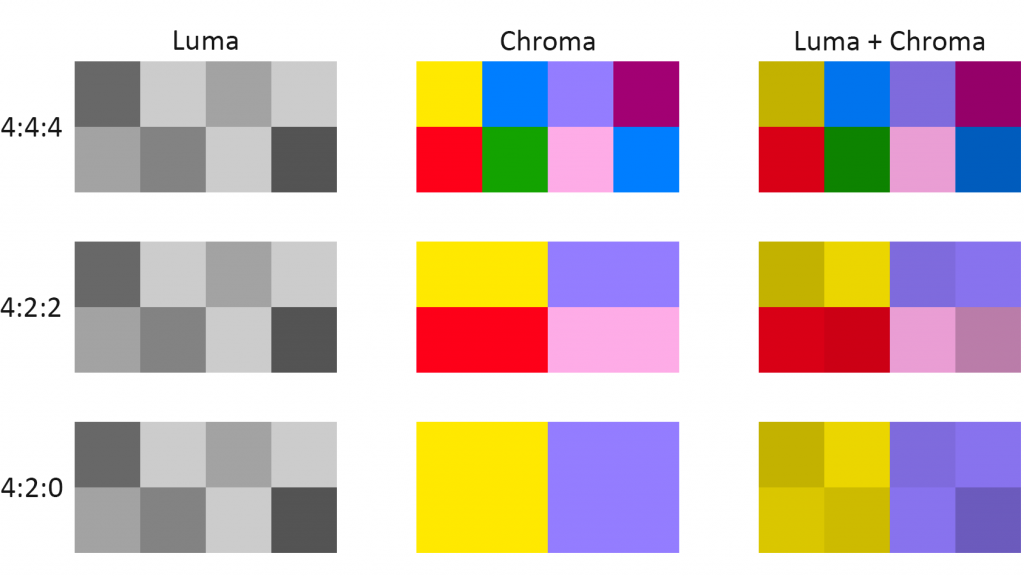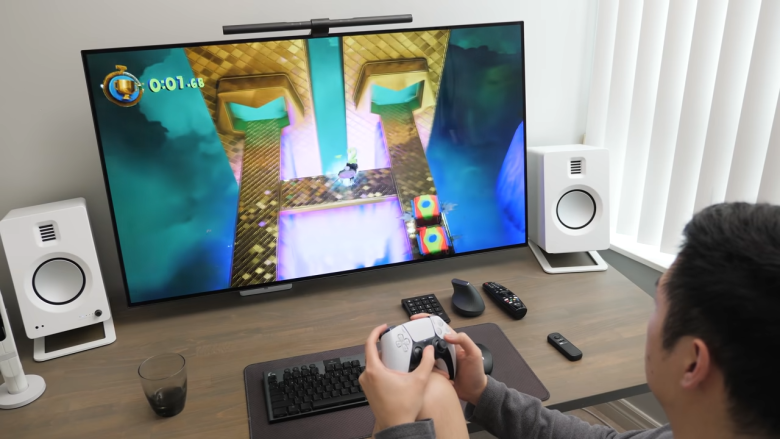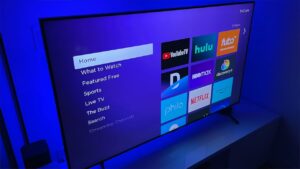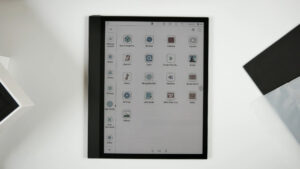At Gawvi, we are fascinated by the versatility of modern televisions. These days, we’ve noticed that people are increasingly using televisions as PC monitors for an immersive gaming experience. The appeal lies in the impressive size and high resolution of 4K TVs, which often surpass the capabilities of even the best gaming monitors.
It’s interesting to note that the best 4K TVs offer affordability without compromising on features and specifications when compared to monitors. While both TVs and monitors serve the same purpose, they differ in size, design, and picture quality.
Now, let us discuss the best TVs you should consider using as PC monitors. Without further ado, let us begin.
1. Sony X77L – 4K Upscaling
After testing the Sony XBR43X800H with its 43-inch screen, I can confidently say it’s the top pick for use as a computer monitor. The price point is just right for the quality it offers. Just an observation: while its 55-inch counterpart comes with a wider stand, this one’s more compact, but there’s still ample space in front to accommodate small items.
The IPS display offers generously wide viewing angles – ideal for group presentations or when you’re lounging beside someone. Its brightness levels easily counteract glare, especially in well-lit rooms. And trust me, its reflex handling is commendable.
When switched to ‘Playing’ or ‘Graphics’ modes, it showcases Chroma 4:4:4. Plus, the input lag is impressively minimal. The response time is apt, ensuring fast-paced content remains fluid.
Although it incorporates a black frame injection to mitigate motion blur, do note it only operates at 120Hz, leading to potential motion duplication. A slight hiccup is its contrast ratio. Especially in dim settings, it might fall short since the 43-inch version uses edge-lit technology. But with its direct LED backlight, the contrast might be a tad lower compared to its larger siblings.
What’s genuinely striking is its color fidelity – so precise that calibration becomes almost redundant. From my extensive experience reviewing TV monitors, this Sony model stands out as the best compact-sized option.
Features:
- Powerful TV Processing.
- Enhanced Color and Details.
- Smart TV Premium.
- Exclusive Features for PlayStation 5.
- Intelligent Motion Handling.
- 4K Upscaling.
- Alexa Compatibility.
- Great viewing angles
- Incredibly low input lag
- Good response time
- No VRR support
- Might not be able to handle intense glare
2. Samsung QN65Q80TAFXZA
Next up, we have the Samsung QN65Q80TAFXZC, which stands out as one of the premier choices for doubling as a large-screen monitor. Its expansive 65-inch display is a dream come true for hardcore multitaskers, enabling numerous windows to comfortably coexist side-by-side.
The VA panel it boasts is nothing short of stellar. It renders deep blacks and vibrant hues with precision. The handling of reflections is top-notch, ensuring clarity even under challenging lighting and neutralizing potential glare.
A significant nod must go to Samsung’s ‘Ultra Viewing Angle’ technology; while the viewing angles are respectable, it’s commendable how the imagery remains undistorted even when seated close to the screen edges.
Its responsiveness is where this TV truly shines. A paltry input lag combined with a swift 120Hz refresh rate ensures a seamless desktop navigation and gaming experience. Covering standard resolutions from 1080p to 1440p, it also nails the 4:4:4 chroma, ensuring text is sharp and easily readable.
Motion handling? Exceptional. It not only has a rapid response time but also integrates a Black Frame Insertion feature to combat motion blur further. For gamers, the inclusion of FreeSync is a blessing to counter screen tearing. However, a slight drawback is its incompatibility with NVIDIA’s G-SYNC.
Color fidelity straight out of the box is impressive. While the unit I experimented with exhibited minor vignetting at the edges and a slight dirty screen effect, it’s crucial to note that such uniformity issues can vary among units.
A noteworthy mention is the BGR subpixel structure, which might occasionally clash with Windows ClearType.
All in all, particularly for expansive conference settings, considering this TV as a PC monitor is not just viable but highly recommended.
Features:
- Direct Full Array 12X.
- Ultra Viewing Angle with Anti-Glare.
- Quantum HDR 12X.
- Quantum Processor 4K.
- Objective Tracking Sound.
- Excellent response time
- Great contrast ratio
- Remarkable reflection handling
- Decent viewing angles
- The corners of the screen appear darker
3. Sony X720E 4k Smart TV
After extensive testing of the Sony X720E, I can attest to its prowess as both a commendable entry-level smart TV and an exceptional choice for a PC monitor. One standout feature is its superior Chroma subsampling, although it’s noteworthy to mention it doesn’t support 1080p @ 120 Hz.
The contrast ratio on the X720E is impressive, delivering a sharp picture quality that meets my expert expectations. Its recent upgrades further enhance its suitability as a PC monitor.
For gamers, this TV is a win. Its low input lag ensures smooth gameplay without any hitches—a feature I personally admire. Plus, its outstanding SDR image quality and refreshingly straightforward, android-free menu are added bonuses.
Features:
- 4K Ultra HD Resolution.
- Voice Search.
- TRILUMINOS PRO Display.
- Motionflow XR 240 Technology.
- Works with Apple AirPlay 2.
- Looks good even if viewed from the sides
- Low input lag is great for gaming
- SDR pictures are good
- Simple, Android-free menus
- Attractive, space-saving design
- It’s super affordable
- Limited app selection
- Blacks aren’t uniform
- Poor HDR black levels
- Limited HDR color performance
4. Samsung NU6900 LED 4K
The Samsung NU6900 Series truly excels as a PC monitor choice. My hands-on review of this unit revealed that, like many budget-friendly TVs, it sheds some premium attributes to center on the core smart TV features.
This is evident in its impressive native contrast ratio, swift response time, and minimal input lag. Indeed, for its price range, the NU6900 offers one of the finest 4K ultra-HD resolutions available.
From my analysis, while the Samsung NU6900 provides commendable picture quality, it forgoes certain enhancements like local dimming, which could have enhanced its visual output.
It’s also worth noting that its HDR capabilities are limited, primarily due to its restricted color gamut range and inability to achieve high brightness levels. However, gamers will particularly appreciate this model, as I observed its low input lag ensures a smooth and immersive gaming experience.
Features:
- 4K UHD Resolution.
- HDR10+ Support.
- PurColor.
- Motion Rate 120.
- Smart TV Capabilities.
- SmartThings App Integration
- Attractive design
- Great contrast and decent black levels
- The decent smart TV experience
- High native contrast
- Low input lag
- Only 2 HDMI ports
- Limited HDR capabilities
- Poor HDR black levels
- No voice interaction
5. Samsung Q80R
After the hands-on experience with the 2019 Samsung Q80 4K LED TV, it is safe to say that it offers exceptional performance, notably for gamers. Positioned squarely between the Samsung Q90R and Q70R in terms of features and performance, the Q80 stands out as one of the premier 4K TVs available.
Its impeccable picture quality is a testament to that claim. Gamers, in particular, will appreciate its superior performance, underscored by its excellent black uniformity, effective local dimming, and impressive native contrast ratio.
Another highlight is its incredibly low input lag, ensuring seamless gaming experiences. Beyond gaming, this model excels across the board, be it for TV shows, sports, movies, or HDR content.
Features:
- 100% Color Volume with Quantum Dots.
- Direct Full Array 8X Backlighting.
- uantum Processor 4K.
- Ultra Viewing Angle.
- Quantum HDR 12X.
- It gives excellent black uniformity
- Remarkable local dimming support and high native contrast ratio
- Has very low input lag
- Built on Ultra Viewing Angle technology
- At the edges of the TV, you may find minimal gray uniformity issues
- You may find it difficult to reach the inputs when the TV is wall-mounted
6. Samsung TU-8000 Series
Samsung Q8FN truly stands out as one of the premier QLED TVs Samsung released in 2018. Its advanced functionalities represent a noticeable upgrade over previous Samsung models.
A standout feature for me, particularly beneficial for people who enjoy gaming, is its impressively low input lag, which ensures swift and precise game responsiveness.
Moreover, its motion handling capabilities are top-tier, eliminating any concerns about motion blur. The color spectrum it offers is vast, even at diverse viewing angles. However, a minor hiccup I noticed is the slight dip in picture quality when viewed from extreme angles.
Beyond its rich visual capabilities, the Q8FN is versatile and apt for various uses, from TV shows and movies to HDR gaming and even as a PC monitor.
Features:
- 100% Color Volume with Quantum Dots
- Direct Full Array Backlight 8X
- Quantum Processor 4K
- Ultra-Viewing Angle
- Quantum HDR 12X
- Versatility
- Excellent wide color gamut
- Feels responsive due to low input lag
- Great motion handling
- Picture quality degrades at an angle
7. SAMSUNG QLED 4K QN90B
SAMSUNG QLED 4K QN90B is a unit that delivers superior performance as a culmination of Samsung’s relentless pursuit of perfection. The display’s Quantum Dot technology isn’t just marketing jargon; it genuinely delivers on its promise of producing exceptionally vibrant colors and heightened contrasts.
For connoisseurs of visual excellence, like myself, the meticulous details this TV presents are nothing short of astounding. Its 4K resolution isn’t just a number but translates to a palpably crisper image quality, elevating both cinematic narratives and the nuances of high-tier gaming.
However, it’s worth highlighting from experience that the 120Hz refresh rate, while a dream for gamers, doesn’t enhance every type of content. And, while its integrated speakers are competent, true audiophiles, like many colleagues I know, would benefit from complementing it with a dedicated sound system for that full auditory immersion.
In essence, for those in the know, the SAMSUNG QLED 4K QN90B stands as a paragon of both aesthetic brilliance and technical prowess.
Features:
- Quantum Dot Technology for vibrant colors
- 4K Ultra HD resolution
- 120Hz refresh rate
- Built-in voice assistant
- Multiple HDMI ports for connectivity
- Sleek and modern design
- Intuitive user interface
- Wide viewing angles
- Low latency for real-time actions
- Easy setup and installation
- Pricey compared to competitors
- Might require external sound setup
8. VIZIO PX 65-G1Vizio P
Vizio PX65-G1 is a TV I’d recommend for rooms with significant ambient light, especially if you desire a screen with greater luminance than the Samsung Q80T QLED. While it doesn’t match Samsung’s expansive viewing angles and lacks support for FreeSync and some gaming features, its visual performance is top-notch when viewed head-on.
The Vizio stands out with its swift responsiveness, attributed to its low input lag. It’s particularly impressive when used as a TV monitor, displaying crisp text due to its adeptness at representing chroma 4:4:4 in prevalent resolutions. For HDR enthusiasts, its vast color range is a significant plus.
A minor drawback: it doesn’t upscale 480p and 720p videos effectively. So, while the Samsung might be your top pick for a computer monitor, the Vizio PX65-G1 is your go-to for optimal viewing in well-lit environments when seated directly in front.
Features:
- UltraBright 3000.
- 384 Local Dimming Zones
- Dolby Vision HDR
- 4K Ultra HD.
- Apple Airplay Integration:
- Outstanding peak brightness in SDR and HDR.
- Deep, uniform blacks.
- Great motion handling.
- Picture quality degrades at an angle.
9. Hisense A6 Series 4K
Hisense A6 Series 4K affirms its prowess in delivering a compelling visual experience. After I had a chance to test it, I must admit, I was impressed by its performance, especially for the price tag it comes with. The intricate detailing it renders elevates binge-watching sessions to a whole new level.
Moreover, the flawless fusion of Google Assistant and Chromecast transforms any room into an advanced entertainment hub, enabling smooth content streaming and interacting with other devices seamlessly.
However, there’s a note of caution regarding its sound. Despite the DTS Virtual, there’s a noticeable absence of depth in some high-octane scenes. An external soundbar might be a worthy addition.
Considering the competitive pricing, though, this minor shortcoming hardly diminishes its commendable overall value.
Features:
- 4K Ultra HD resolution
- Built-in Google Assistant and Chromecast
- DTS Virtual
- Bluetooth audio streaming
- Multiple device input options
- Vibrant and sharp visuals
- Seamless streaming
- Intuitive Google Assistant
- Competitive price point
- Sound depth can be improved
- Chromecast Requires occasional restarts
Using the TV as a computer monitor: Everything you Need to Learn
You’re not the first to imagine what a huge desktop monitor would be like.
Think of all the multi-tasking and interactive gaming you could do if you had a 50-or 60-inch display instead of a regular 24-inch monitor! Yet you’ve also noticed that as the shows become larger, they tend to become too costly.
Thankfully, you do have a large screen in your house, though — a TV. By the end of each day, isn’t HDTV just a huge, living-room-oriented screen monitor?
While you may use TV as a guide in certain cases, it doesn’t imply it’s the right choice. It’s far less fun, relaxed and open than you imagined it should be.
You can certainly use TV as your PC display, but your TV would always function in a snap if you desperately require a second computer. Here’s what you need to know on how to set up a TV as a screen monitor — and why you don’t want to.
Will it even work?
Oh, well, yes. You will need a unique cable, based on the output of your device and the input of your HDTV, so you might need to look at a few settings, but you shouldn’t have too much difficulty connecting most modern PCs to most modern HDTVs.
Present HDTVs have an HDMI monitor on them. Some newer HDTVs have DVI inputs, while some have VGA inputs expressly built for “Computer use.” If your graphics card has an HDMI connection, it’s good to go: just use the HDMI cable to link your CPU to your HDMI.
You can need to use a different panel, such as the DisplayPort display of your video device, if you want to use your HDTV as a second or third monitor. You ‘d like to use a different cable in this situation.
Getting your PC ready
You will also need to decide whether your graphics card (or your PC’s built-in illustrations) is equipped to meet the objectives of your HDTV. To do so, you would first need to explore the aims of your HDTV by advising the maker’s manual.
A few HDTVs have non-standard objectives; it’s anything but a given that your HDTV will be supported. Many sticks to normal 720p, 1080p, or 4 K goals are as good as they can be. Next, locate the most extreme objectives of your design card / coordinated design support.
4K TV as Computer Monitor Considerations
Maybe you feel the 4K Screen is too large to be used as a PC monitor. This is definitely a valid concern. And while the TVs may be overwhelming, particularly if they’re used up close, you may resolve the issue by simply sitting a little farther away from the Screen than you can from your usual computer monitor.
4K TV Connections
There will be a few other things that need to be modified or disabled, such as “dynamic contrast,” but the 4 K Display will do what you need in the manufacturer’s guide and guidance booklet.
Once you make the connections, your 4K TV/computer monitor combo will be a space saver and a beautiful smart upgrade.
What is Chroma Subsampling?
Chroma subsampling is a technique used in video and image compression to reduce the amount of data required to represent color information. At its core, it leverages the human visual system’s sensitivity differences to brightness (luminance) and color (chrominance).
Our eyes are more sensitive to changes in brightness than they are to changes in color. Thus, by reducing the resolution of the color information relative to the brightness information, significant data savings can be achieved without a perceptible loss in image quality.
To understand chroma subsampling, it’s essential to know the basics of color representation in digital images. Digital images and videos are typically represented using three primary color channels: red, green, and blue (RGB).
For compression and broadcasting purposes, this RGB representation is often converted into a different color space called YCbCr. In this space, ‘Y’ represents luminance (brightness), while ‘Cb’ and ‘Cr’ represent chrominance (color) components.
The process of chroma subsampling involves reducing the resolution of the Cb and Cr channels while keeping the Y channel at its original resolution. This is done because, as mentioned earlier, our eyes are less sensitive to fine details in color than they are to details in brightness.
By doing this, the overall data required to represent an image or video can be significantly reduced, allowing for more efficient storage and transmission.
Chroma subsampling is often represented using a three-part ratio, such as 4:4:4, 4:2:2, or 4:2:0. The first number refers to the sample size, typically a 4×4 block of pixels. The next two numbers indicate the horizontal and vertical sampling rates of the chroma channels.
For instance, 4:4:4 means no subsampling, 4:2:2 means the chroma channels are sampled at half the horizontal resolution, and 4:2:0 means they are sampled at half the horizontal and half the vertical resolution.
It’s worth noting that while chroma subsampling can lead to more efficient data storage and transmission, it can also introduce artifacts in certain situations.
For example, when dealing with images or videos with sharp color transitions, subsampling can lead to visible color bleeding or reduced color detail. This is why it’s crucial to choose the appropriate subsampling ratio based on the specific needs and characteristics of the content.
The Best Size For A PC Monitor
The computer is more oriented around a desk of some kind which means the best TV for a PC monitor will have to be a bit smaller as well. Most often as well you’ll be sitting much closer which means you do not need a TV that is as large by the same token.
With that in mind, most of my recommendations fall around 43 inches and under, but many people are turning their living rooms into a PC room which is why I’ll also recommend larger TV sets. The key is that it has better than average chroma subsampling in the end.
Another thing to remember about these smaller (or larger) smart TVs, is that there are too many of them in circulation or nearly none at all.
I take this heavily into account when deciding on the best TV for a PC monitor because I do not want you overpaying for average performance, or being unable to find a television that is worth the money.
PC Monitor Input Lag
Another huge part of finding the best TV for a PC monitor is taking into account the input lag since you’ll be using external devices to control your PC and in turn your smart TV. Not to mention many people do use their PCs for playing video games.
So this is certainly a dual-purpose metric that allows you to knock out two birds with one stone. tested input lags
I do not see many smart TVs anymore that fall under 19-20 ms input lag, but if they are released in the near future you can be sure they’re likely to make the list.
Aside from those rare cases, I recommend that the best TV for a PC monitor be one that falls around 20 ms, but no higher than 30 ms as that is when things start to be noticeable.
Ideal PC Monitor Panel Types
There is a large variety of panel types for smart TVs, but only so many are actually worth the cost or reliability over time. This is especially true for the best TV for a PC monitor because it should be designed to be used over the course of many years, not one or two.
So with the number of TVs I’ve tested, I’ve noticed a direct relationship between the number of LED panels and how reliable they seem to be making them the best options for use as a PC monitor. A close second would have to be an OLED or QLED style smart TV, but those are variants of LED in the end.
PC screen types
An important thing to note here is that curve TVs did not make it into the top 5 TVs for PC monitors. This is because they are more of a stylistic design rather than a truly effective form of transferring information from the screen to you.
They have a more narrow viewing angle and often can not handle reflections very well which makes them less than ideal for most users as a PC monitor. Though, if you are dead-set on a curved TV, leave a comment and I will be happy to find the best option for you.
Response time
Response time, frequently associated with the input lag explains how long it takes for the pixels of a monitor to switch colors between scenes. HDTVs can have very different response times than computer monitors do.
HDTVs tend to prefer darker colors, greater contrast, and broader viewing angles— all of which offer a longer response time.
Computer monitors tend to drop some of the viewing and image processing angles for faster response times. In the fast-paced video and game sequences, if you use a show with a slower response time, you may see “ghosting”
Refresh rate
Another aspect that could affect performance is the refresh rate of a monitor. The refresh rate is the number of times the “update” monitor displays, or re-draws, the picture per second. Many current screens have a 60Hz refresh rate, indicating that they refresh their picture 60 times per second.
But you’ve probably also seen higher-end gaming monitors and HDTVs with higher advertised refresh rates—120Hz, 144Hz, or even 240Hz. This can be misleading, however, because a computer monitor with a 120Hz refresh rate may not be the same as an HDTV with a 120Hz refresh rate.
Frequently Asked Questions
Can you use the TV as a PC monitor?
Yes, you can use a TV as a PC monitor. In order to do this, you’ll need to connect your PC to the TV using one of the following methods:
- HDMI: Modern TVs and PCs typically have HDMI ports, which make it easy to connect them. You’ll need an HDMI cable to do this. Simply plug one end of the cable into your PC’s HDMI port and the other end into the TV’s HDMI port. Then, select the corresponding HDMI input on your TV using the remote control.
- DisplayPort or Mini DisplayPort: Some PCs have DisplayPort or Mini DisplayPort outputs, which can be used to connect to a TV with a compatible input. If your TV doesn’t have a DisplayPort input, you may need an adapter to convert the DisplayPort output to HDMI or another supported format.
- DVI: If your PC has a DVI output and your TV has a DVI input, you can connect them using a DVI cable. If your TV doesn’t have a DVI input, you may need an adapter to convert the DVI output to HDMI or another supported format.
- VGA: Older PCs and TVs may have VGA ports. You can connect them using a VGA cable, but keep in mind that VGA connections only support analog video and may not provide the same quality as digital connections like HDMI or DisplayPort.
What size TV is best for 4k?
The ideal TV size for 4K resolution (3840 x 2160 pixels) depends on your viewing distance, personal preferences, and the space available in your room. Generally, larger TVs can take better advantage of the increased resolution provided by 4K, as the higher pixel density makes it easier to see finer details.
A common method to determine the appropriate TV size is to use the recommended viewing distance, which is based on the screen’s diagonal size and the resolution. For 4K TVs, a common recommendation is to sit at a distance of about 1 to 1.5 times the screen’s diagonal size.
For example:
- For a 40-inch 4K TV, the recommended viewing distance would be between 3.3 and 5 feet (1 to 1.5 meters).
- For a 55-inch 4K TV, it’s 4.6 and 6.9 feet (1.4 to 2.1 meters).
- For a 65-inch 4K TV, the recommended viewing distance would be between 5.4 and 8.1 feet (1.6 to 2.5 meters).
Consider the space available in your room and how far you’ll be sitting from the TV. Then, choose a TV size that provides a comfortable viewing experience without being too large for your room or too small to take full advantage of the 4K resolution. Keep in mind that individual preferences may vary, and some people might prefer larger or smaller screens based on their viewing habits and personal tastes.
Why should I use TV as a PC monitor?
Using TV as a PC monitor is a good idea since modern-day TVs offer sky-high resolutions and vivid colors. It is also very convenient since you can connect your PC to the TV and relax on your couch while gaming or watching movies or TV shows.
Can I use the TV as a PC monitor wirelessly?
Yes, you can use a TV as a PC monitor wirelessly. There are several methods to do this, depending on the capabilities of your TV and PC:
- Miracast: Miracast is a wireless display standard that allows you to mirror or extend your PC’s screen on a TV without using cables. Many modern TVs and Windows PCs support Miracast natively. To use Miracast, ensure both your TV and PC are connected to the same Wi-Fi network. On your Windows PC, press the Windows key + P, then select “Connect to a wireless display.” Your TV should appear in the list of available devices. Select your TV to begin screen mirroring.
- Wi-Fi Direct: Some TVs and PCs support Wi-Fi Direct, which allows for direct wireless connections between devices. Check your TV and PC’s user manuals to see if they support Wi-Fi Direct, and follow the instructions to establish a connection.
- Chromecast or other streaming devices: You can use a Google Chromecast or similar streaming device to cast your PC’s screen to your TV. Connect the Chromecast to your TV’s HDMI port, set it up using the Google Home app, and connect it to the same Wi-Fi network as your PC. In Google Chrome browser on your PC, click on the three-dot menu in the top-right corner, and select “Cast.” Choose your Chromecast device, and you can cast a specific browser tab, your desktop, or a specific application to your TV.
- Apple TV and AirPlay: If you have an Apple TV, you can use AirPlay to wirelessly mirror your Mac or Windows PC’s screen to the TV. Connect the Apple TV to your TV’s HDMI port, and ensure both the Apple TV and your PC are connected to the same Wi-Fi network. On a Mac, click on the AirPlay icon in the menu bar, and select your Apple TV. On a Windows PC, you’ll need a third-party application like AirParrot to enable AirPlay support.
What size of the TV is good for gaming?
This is the factor that largely depends on how much space you have available and how far from the screen you plan to be. When you consider these factors, the size that is considered optimal is between 40 and 55 inches.
The Bottom Line
We’ve carefully assessed the current market to determine the top recommendations for PC monitor TVs across various price ranges. Our team takes into account crucial factors such as price, customer reviews, and availability to provide you with the most suitable options.
If you prefer to take charge of your decision-making process, we’ve compiled a comprehensive list of our TV ratings. However, it’s important to strike a balance and not get overwhelmed by the intricate details.
While it’s true that no battery is flawless, most batteries on the market today are designed to meet the needs of the majority of users. Subtle variations in performance often go unnoticed during normal usage.
At Gawvi, we prioritize your satisfaction and believe that our recommendations will cater to the requirements of most individuals. Please note that we do not own any of the mentioned products, but our evaluations are based on extensive research and analysis.
Choose with confidence, knowing that our suggestions aim to provide you with the best options available in the battery market.
Related Posts:
- 8 Best Budget TVs 2024 - Finding Affordable Televisions
- 7 Best Affordable Portable TVs in 2024 - Take Your…
- Top 12 Best TVs for Bedroom 2024 - Ideal for Netflix…
- 8 Best Flat Screen TVs 2024 - Sleek, Stylish, and Superior
- The Ultimate Guide to Rear Projection TVs 2024 -…
- Different Features of 65" and 60" TVs - 2024 General…


